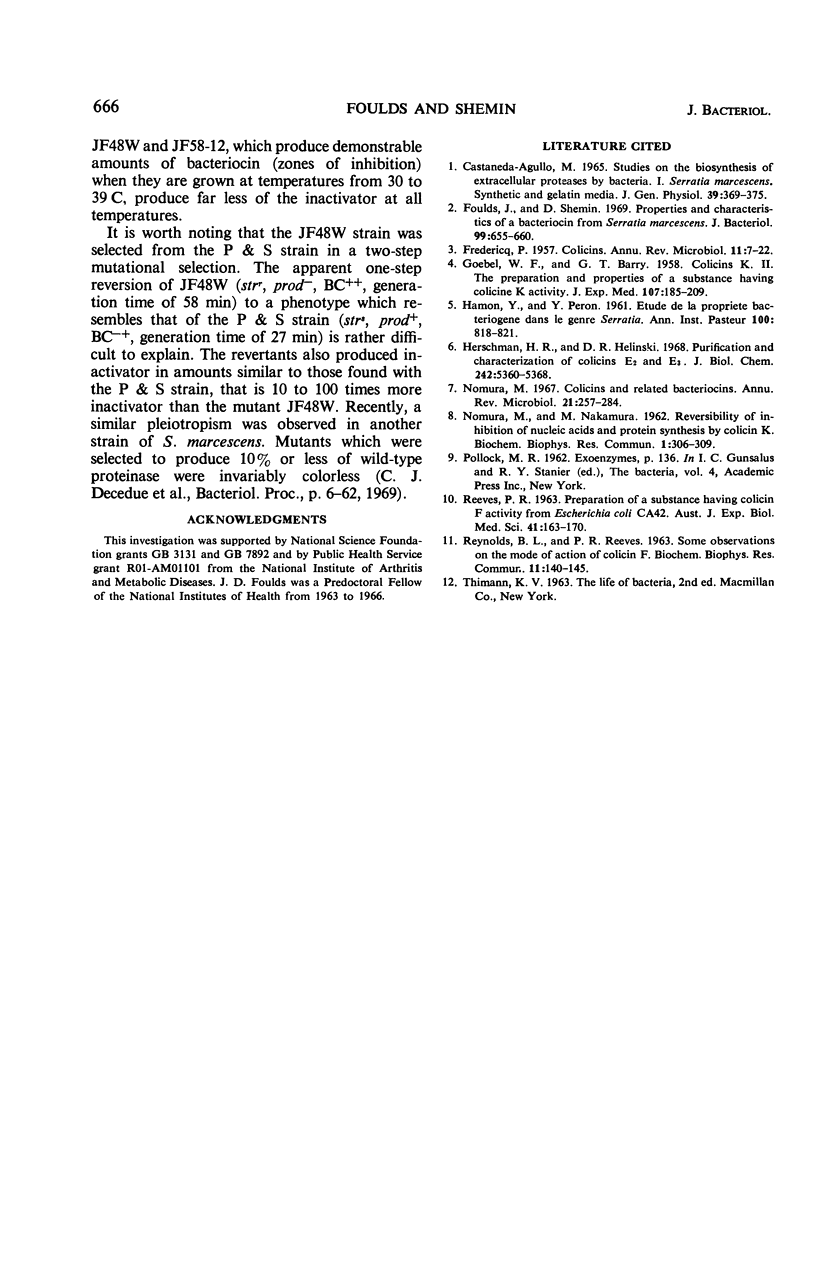Abstract
We have found that Serratia marcescens strain P & S is bacteriocinogenic. However, the phenotypic expression of bacteriocin activity depends upon the temperature at which the cells are grown. When the organism is grown at 30 to 37 C, no bacteriocin activity can be demonstrated, whereas when it is grown at 39 C bacteriocin activity is readily observed. It appears that the P & S strain concomitantly synthesizes a bacteriocin and a substance which not only can inactivate the bacteriocin but also has a high activation energy for inactivation. This inactivator readily loses its activity when heated at 39 C for 1 hr. Two mutants were isolated from the P & S strain which can produce active bacteriocin when grown at temperatures from 30 to 39 C. It is significant that these mutants have considerably less bacteriocin inactivator. The data suggest that the inactivator is an extracellular protease. The ability of one of these mutants, JF58-12, to produce active bacteriocin at temperatures between 30 and 39 C is a stable property, whereas in the other mutant, JF48W, this property is unstable. JF48W was selected from the P & S strain in two steps: first a streptomycin-resistant variant (strain A-10) was isolated and from this mutant a strain (JF48W) was isolated which not only synthesized little of the inactivator but also did not synthesize the red pigmnet prodigiosin. This latter pleiotropic mutant appears to revert in one step to a phenotype similar to the P & S strain, since it is streptomycin-sensitive and produces prodigiosin and normal amounts of inactivator and the demonstration of bacteriocin activity is temperature-dependent.
Full text
PDF





Images in this article
Selected References
These references are in PubMed. This may not be the complete list of references from this article.
- CASTANEDA-AGULLO M. Studies on the biosynthesis of extracellular proteases by bacteria. I. Serratia marcescens, synthetic and gelatin media. J Gen Physiol. 1956 Jan 20;39(3):369–375. doi: 10.1085/jgp.39.3.369. [DOI] [PMC free article] [PubMed] [Google Scholar]
- FREDERICQ P. Colicins. Annu Rev Microbiol. 1957;11:7–22. doi: 10.1146/annurev.mi.11.100157.000255. [DOI] [PubMed] [Google Scholar]
- Foulds J. D., Shemin D. Properties and characteristics of a bacteriocin from Serratia marcescens. J Bacteriol. 1969 Sep;99(3):655–660. doi: 10.1128/jb.99.3.655-660.1969. [DOI] [PMC free article] [PubMed] [Google Scholar]
- GOEBEL W. F., BARRY G. T. Colicine K. II. The preparation and properties of a substance having colicine K activity. J Exp Med. 1958 Feb 1;107(2):185–209. doi: 10.1084/jem.107.2.185. [DOI] [PMC free article] [PubMed] [Google Scholar]
- HAMON Y., PERON Y. [Study of the bacteriocinogenic property in the genus Serratia]. Ann Inst Pasteur (Paris) 1961 Jun;100:818–821. [PubMed] [Google Scholar]
- Herschman H. R., Helinski D. R. Purification and characterization of colicin E2 and colicin E3. J Biol Chem. 1967 Nov 25;242(22):5360–5368. [PubMed] [Google Scholar]
- NOMURA M., NAKAMURA M. Reversibility of inhibition of nucleic acids and protein synthesis by colicin K. Biochem Biophys Res Commun. 1962 May 4;7:306–309. doi: 10.1016/0006-291x(62)90196-1. [DOI] [PubMed] [Google Scholar]
- Nomura M. Colicins and related bacteriocins. Annu Rev Microbiol. 1967;21:257–284. doi: 10.1146/annurev.mi.21.100167.001353. [DOI] [PubMed] [Google Scholar]
- REYNOLDS B. L., REEVES P. R. Some observations on the mode of action of colicin F. Biochem Biophys Res Commun. 1963 Apr 23;11:140–145. doi: 10.1016/0006-291x(63)90081-0. [DOI] [PubMed] [Google Scholar]



